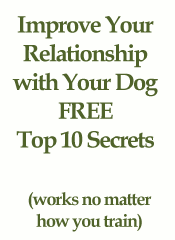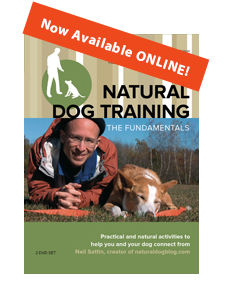Ideas for dog training articles abound, it seems. Sunday morning I was eating breakfast at a local brunch joint (hello Pepperclub!) when one of the other patrons overheard that I wrote a dog training blog. It seems that she has a new Bergamasco puppy who has the tendency to pee when she meets people, especially men. While submissive urination isn't exactly a topic for the breakfast table (sorry Tonya), it is great for your Tuesday morning NaturalDogBlog reading (unless you're reading over breakfast, I suppose). We've already discussed how to introduce your dog to another dog, so now let's talk about the best way to introduce your dog to another person with the most healthy emotional response possible. For the dogs AND the humans involved.
Submissive Urination is an "overload" problem, just like aggression or hyperfriendliness. When our dog is physically tense and there's too much energy going on in the environment for our dog to handle, that energy builds up until it finds SOME way to escape. Considering that most humans are very predator-like to a dog (especially men - sorry guys) that means that there is often a LOT of intensity in human-canine introductions - and that intensity needs an outlet. You know that feeling of relief you get when you have to pee really bad and you finally find a spot (in a bathroom, of course!) to do it? Well, that's similar to the "relief" that our dogs feel when they pee in front of another person - it's a way for them to deal with the tension they're experiencing. Not that it's a conscious decision by any means, it's a reaction to the emotional charge of a situation that happens on a purely physical level - the dog's internal emotional stability mechanism at work.
Remember that your FIRST priority as a dog owner is to help your dog be as physically relaxed as possible. Your SECOND priority is to teach your dog what to do with all of their energy. Now there are a lot of priorities vying for the third position, but among them is "manage situations so that your first two priorities are possible". Many of the posts that I make will fall into this category, and my hope is that over time you'll internalize the natural dog training approach to looking at a situation and intuitively know how to handle it - or at least you'll be able to come up with a strategy upon further reflection. In fact, maybe we'll even have some contests in the future, with the best responses winning some thrilling prizes! Are you excited? I hope so! Now I'll give you something to do with that energy...keep reading! 🙂
OK - back on topic. Your task is essentially to manage the first 15 minutes of your dog's interaction with this other person. After the initial 15 minutes, the energy level of the situation will generally calm back down to a more normal level, and more informal interaction between your dog and the new person is possible. With that in mind, here are some steps to follow when introducing your dog to another person:
- Make the introduction OUTSIDE. The intensity of meeting someone new (or an old friend) is much easier for a dog to take when they're outside. When you're outside there are many more places for that emotional energy to go - whereas when you introduce your dog to someone in the entryway to your apartment/home, there's almost nowhere for the energy to go but into your dog. So when your guest arrives, meet them outside - have them stand away from the door at least several feet, if possible. Also, if your dog does happen to pee, there won't be any mess to clean up. However, if you follow all of these steps you will be taking care of the submissive urination issue.
- DON'T introduce them. Ask the other person to ignore your dog. Prepare the other person beforehand if possible. They should pretend that your dog isn't even there. You should also let them know that you will be devoting your initial attention to helping your dog through the situation - so they won't expect serious social contact with you until everything has calmed down. If you can, just take a walk together around the block. As long as the other person is ignoring your dog and you all start walking in a given direction, your dog's focus will probably shift rapidly to the "hunt" that you're all on. Your dog will get used to the other person's presence, and the "introduction" will have been made. The face-to-face encounter is VERY difficult for a dog to manage, especially if it's forced. When a dog senses another dog, for instance, the dynamic between them begins at quite a distance - hundreds of feet, in some cases. By the time the two dogs get to each other's space, they've had quite a lot of time to sort out the introduction - and even then the best thing would be for those two dogs to have something common to do together. It's no different when your dog meets a person. The best introduction is a non-introduction.
- Take breaks to play or push with your dog. Have a couple tug toys handy, and take breaks to play tug (don't forget to let your dog win!). If you have been working on the Natural Dog Training technique of "pushing", take pushing breaks - calling your dog's name, getting a good push out of them, and using the exercise to help them get stress out of their bodies.
- If your dog is all energized at the instant they see the other person, see step #3. Your dog is already energized, so you have to give your dog something to do with their energy. Satisfying their prey drive will help them relax AND redirect that energy back to you, where it belongs. In the meantime, ask the other person to start slowly walking AWAY from you. Once you're done pushing/playing tug, you will catch up to them and walk together. What your dog is learning here is something like "oh - they way that it FEELS to meet another person is to play/push with my owner. So...when I feel that feeling of energy whirring inside of me when I see a stranger, the way that I handle it is by interacting with my owner - NOT with the other person".
- Take breaks to help your dog relax with massage. Your goal is to use touch to get your dog as relaxed as possible. Imagine that you're your dog's massage therapist. See this article on how to relax your dog for more thoughts about getting your dog into a calm, relaxed state.
- Manage the other person. Ask the other person to stay calm. If they interact with your dog at all it should be as calmly as possible. Slow movements. Soft voice. None of that high pitched crazy "oh-bujee-bujee-bujee-so-nice-to-see-you-oh-you're-so-cute" craziness. None of it! In the case of submissive peeing, it would also be helpful for the other person to avert their gaze, hold out their hand palm up, and let the dog come to them. In other words - they should not do what most people do, which is to approach the dog, reach out overhand to pet it on the head, get all crazy with their voice, and get in the dog's face. Please don't let them do this. If they (the humans) are craving more interaction, give them a couple treats that they can give to the dog - but under one condition, they should not talk to the dog. No asking for a paw, or sitting - none of that. Just calmly handing over the treat, maybe with a slow, gentle massage on the dog's body with the other hand. Then keep moving.
- After the initial 15 minutes or so, once you sense that your dog is relaxed and relatively ambivalent about the presence of this other person, you're safe to go inside - or do whatever it was that you were going to do. Just remember to keep it chill if you're going inside. If you're staying outside, perhaps you could teach the other person the correct way to play tug-of-war with your dog and let them play together (as a way of satisfying the person's desire to interact with your dog - your dog will be fine either way).
If you have to do the introduction inside, make sure you follow steps #2, #5, and #6 - focus on the non-interactive and relaxing aspects of the process. You want to keep things as chilled out as possible when you're indoors, especially if you're dealing with submissive urination. I often will have a spot defined as THE spot for a dog to hang out (like a dog bed in the living room, for instance), and I will use treats to encourage the dog into that place (initially) as well as to remain in that place (by slowly doling out treats during that initial 15 minute period). In between the treats you can use massage to help your dog stay calm and relaxed. Once you sense that the intial intensity has passed, you can let your dog off their spot - and they will probably go to investigate the new person. Make sure that the person stays calm and as non-interactive as possible, simply holding out their hand palm-up for your dog to sniff. Then give your dog something to do - maybe some rawhide or a knuckle bone to chew on.
Another important part of this process is to tell the other people in your life about what you're trying to do with your dog - keeping your dog relaxed and giving your dog healthy outlets for their energy. If you're taking away the way that a person has traditionally interacted with dogs, you have to give them some alternative - so don't focus on what they can't do, focus on what they CAN do. Though this is probably obvious, you can send them here to this blog as a resource for finding out more about your new methodology - what you're doing, and why it works. Hopefully they will find it to be a much more satisfying way of interacting with the dogs in their life.
Well, I think that just about covers it! Now you have a lot of techniques at your command - both for helping the dogs in your life and for helping the people in your life (with their canine relationships). Furthermore, as you help your dog relax in these situations and give them something to do with their energy, your dog will learn to trust you as the ultimate resolver of all their stress. Whenever they "feel that feeling" of energy whirring within them, they will look to you for the solution. Your interactions will become effortless, as your dog's behavior will orient around you more and more, and you will intuitively choose the most fulfilling ways of responding to the energy that life throws your way.
Now I'm going to start rounding up prizes for that contest! As always, feel free to comment/question below or send e-mail to: neil at naturaldogblog dot com





Help!
I just agreed to take the big step and move in with my girlfriend of 2 years. The problem is that she owns and loves her dog very much. My problem is I don’t particularly know anything about dogs, and I really want my new living arrangements to work out.
Actually, I am sought of uncomfortable around the dog and want to broaden my horizons, so to speak, on the subject, and smooth this whole matter out.
I read your article on how to introduce your dog to another person.
It was quite interesting but still a bit above my very basic knowledge of dogs, almost non-existent.
I am interested in all kind of to dog information and tips.
Hi Randee,
Thanks for writing. At this point, you should hopefully be able to get the information that you need from my Learn the Basics section. Just read through the articles in order. In particular, you might want to focus on the article of "how to relax your dog", as that's a very rewarding way to interact with a dog that won't challenge your sensibilities too much. Then move on to some of the play-training - like the article on tug-of-war. But only once you're comfortable. Also, Eleven Essential Things Everyone Should Know About Dogs might help you too.
In general, my advice is to remember to breathe, stay as relaxed as possible, and try not to have any expectations. Just pay attention to the dog, in the moment, and respond accordingly! See...simple! The same thing also usually works for human-to-human relationships as well. 🙂
Keep us posted!
Thank you, genuinely, for taking the time out to respond to my question.
You gave me three great links to look at, and I intend to have a look. However, I just wanted to thank you in the meantime.